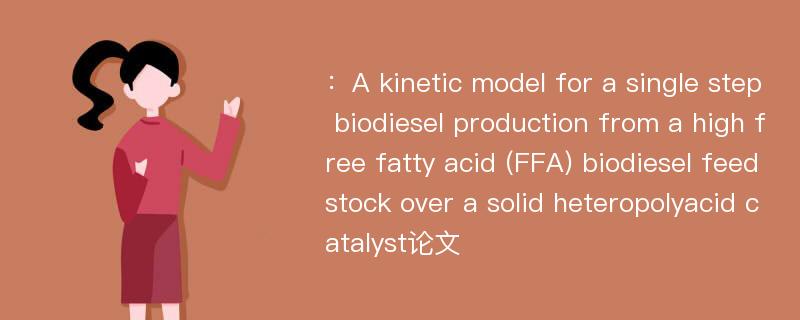
本文主要研究内容
作者(2019)在《A kinetic model for a single step biodiesel production from a high free fatty acid (FFA) biodiesel feedstock over a solid heteropolyacid catalyst》一文中研究指出:Production of biodiesel from yellow grease(waste cooking oil and waste animal fats) is fast emerging as a promising alternative to address the twin challenges before the biodiesel industry today-fluctuation in prices of vegetable oil and the food versus fuel debate. Yellow grease has a high percentage of free fatty acids(FFA) and proves to be an unsuitable feedstock for biodiesel production from commercially viable alkalicatalyzed production systems due to saponification problems."Green" methodologies based on heterogeneous solid acid catalyzed reactions have the potential to simultaneously promote esterification and transesterification reactions of yellow grease to produce biodiesel without soap formation and offer easy catalyst separation without generation of toxic streams. This paper presents kinetic studies for the conversion of model yellow grease feeds to biodiesel using a heteropolyacid supported on alumina(HSiW/Al2O3) using a batch autoclave. Three model yellow grease feeds were prepared using canola oil with added FFA such as palmitic, oleic and linoleic acid. A pseudo homogeneous kinetic model for the parallel esterification and transesterification was developed. The rate constants and activation parameters for esterification and transesterification reactions for the model yellow grease feeds were determined. The rate constants for esterification are higher than the transesterification rate constants. The kinetic model was validated using the experimental biodiesel data obtained from processing a commercial yellow grease feed. The kinetic model could be used to design novel processes to convert various low-value waste oils, fats and non-food grade oils to sustainable biodiesel.
Abstract
Production of biodiesel from yellow grease(waste cooking oil and waste animal fats) is fast emerging as a promising alternative to address the twin challenges before the biodiesel industry today-fluctuation in prices of vegetable oil and the food versus fuel debate. Yellow grease has a high percentage of free fatty acids(FFA) and proves to be an unsuitable feedstock for biodiesel production from commercially viable alkalicatalyzed production systems due to saponification problems."Green" methodologies based on heterogeneous solid acid catalyzed reactions have the potential to simultaneously promote esterification and transesterification reactions of yellow grease to produce biodiesel without soap formation and offer easy catalyst separation without generation of toxic streams. This paper presents kinetic studies for the conversion of model yellow grease feeds to biodiesel using a heteropolyacid supported on alumina(HSiW/Al2O3) using a batch autoclave. Three model yellow grease feeds were prepared using canola oil with added FFA such as palmitic, oleic and linoleic acid. A pseudo homogeneous kinetic model for the parallel esterification and transesterification was developed. The rate constants and activation parameters for esterification and transesterification reactions for the model yellow grease feeds were determined. The rate constants for esterification are higher than the transesterification rate constants. The kinetic model was validated using the experimental biodiesel data obtained from processing a commercial yellow grease feed. The kinetic model could be used to design novel processes to convert various low-value waste oils, fats and non-food grade oils to sustainable biodiesel.
论文参考文献
论文详细介绍
论文作者分别是来自Green Energy & Environment的,发表于刊物Green Energy & Environment2019年03期论文,是一篇关于,Green Energy & Environment2019年03期论文的文章。本文可供学术参考使用,各位学者可以免费参考阅读下载,文章观点不代表本站观点,资料来自Green Energy & Environment2019年03期论文网站,若本站收录的文献无意侵犯了您的著作版权,请联系我们删除。
